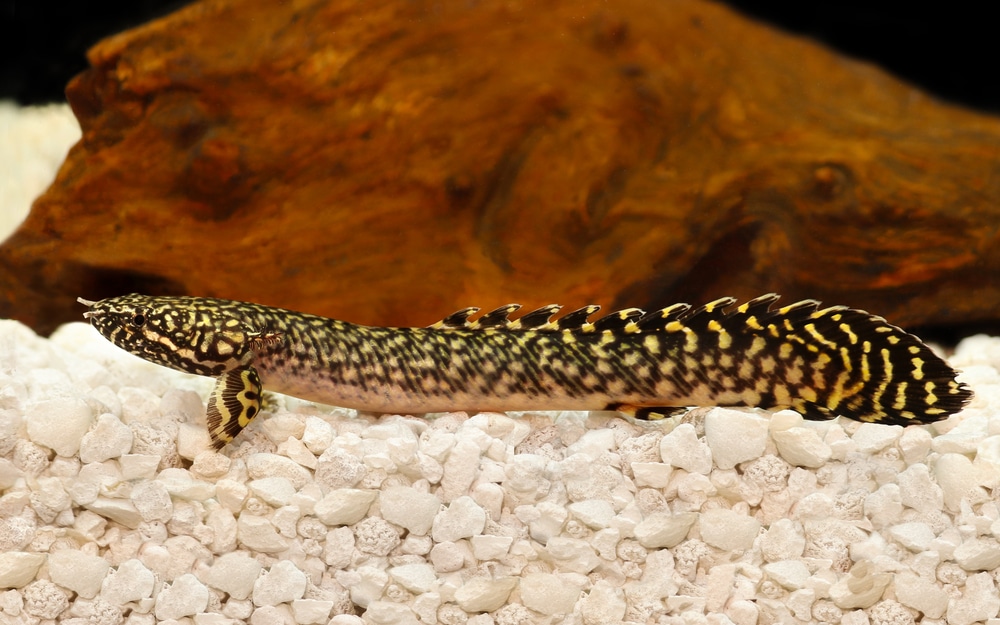Marbled Bichir
If you're in search of an aquatic pet that's unique, unusual, and fascinating, look no further than the marbled bichir. This ancient fish, known for its snake-like body and long dorsal fin, is quickly gaining popularity among fish enthusiasts.
Pain Points Related to Marbled Bichir
One potential pain point related to owning a marbled bichir is its size - these fish can grow up to 20 inches long, which means they require a fairly large aquarium. Additionally, they are predatory in nature, which means they may eat smaller fish in the tank. Finally, because they are air breathers, they require access to the surface of the water.
Target of Marbled Bichir
Marbled bichirs are native to West and Central Africa, where they inhabit swamps, lakes, and rivers. They are typically found in water with a pH range of 6.0-8.0 and a temperature range of 75-82℉.
Summary of Main Points Related to Marbled Bichir
Overall, marbled bichirs are fascinating fish that require some expertise to care for properly. They thrive in large aquariums with plenty of hiding spots, as well as access to the surface of the water. While they may eat smaller fish, they can coexist with larger, similarly sized fish. They are also air breathers, which means they require specific water conditions in order to thrive.
Personal Experience with Marbled Bichir
My first experience owning a marbled bichir was both exciting and challenging. While these fish have a striking appearance, I quickly learned that they require more space and specific water conditions than I initially anticipated. However, once I perfected the water conditions and provided ample hiding spots, my marbled bichir became a showstopper in my aquarium.

Marbled bichirs are best suited for experienced fish owners who have the time and resources to provide for their specific needs. While caring for these fish can be challenging, the reward of watching them thrive in a well-maintained aquarium is well worth the effort.
Caring for Juvenile Marbled Bichir
If you're considering adding a juvenile marbled bichir to your aquarium, there are a few things to keep in mind. First, these fish require a minimum tank size of 30 gallons, with plenty of hiding spots and open swimming space. Second, they are predatory and may eat smaller fish in the tank, so it's important to only keep them with similarly sized species. Finally, juvenile marbled bichirs tend to be shy and may take a few weeks to acclimate to their new environment.

Water Conditions for Marbled Bichir
When it comes to water conditions, marbled bichirs prefer a pH range of 6.5-8.0 and a temperature range of 75-82℉. It's also important to ensure that the aquarium has a well-functioning filtration system and is properly cycled before introducing any fish.
Breeding Marbled Bichir
While breeding marbled bichirs can be challenging, it is possible with the right set up and some patience. These fish are known to breed in captivity, and generally require a separate breeding tank with stable water conditions and plenty of hiding spots.

Question and Answer About Marbled Bichir
Q: How often should I feed my marbled bichir?
A: Marbled bichirs are carnivorous and should be fed protein-rich foods such as shrimp, worms, and small pieces of meat. It's recommended to feed them 2-3 times a week.
Q: Can marbled bichirs live with other fish?
A: Marbled bichirs can coexist with similarly sized fish that are not small enough to be considered prey.
Q: What size tank do marbled bichirs need?
A: Juvenile marbled bichirs require a minimum tank size of 30 gallons, while adults need at least a 75 gallon tank.
Q: Do marbled bichirs need access to the surface of the water?
A: Yes, marbled bichirs are air breathers and require access to the surface of the water in order to breathe.
Conclusion of Marbled Bichir
If you're up for the challenge of caring for a marbled bichir, you'll be rewarded with a unique, fascinating, and impressive fish. From their snake-like appearance to their predatory nature, these fish have a lot of charm and personality. By understanding their specific needs and providing them with a suitable environment, you can enjoy the beauty of marbled bichirs in your own aquarium.
Gallery
Marbled Bichir (Polypterus Polli) - Aqua Imports

Photo Credit by: bing.com / bichir marbled polypterus polli imports aqua
BICHIR: Polypterus – Species Biology, Habitat And Distribution – BAP

Photo Credit by: bing.com / polypterus bichir species palmas distribution biology habitat
Ornate Bichir – Scales And Tails Of Ohio
Photo Credit by: bing.com / bichir polypterus delhezi ornatipinnis aquarium ornate catfish eel enguia poissons fleuris poisson anguille ornamentado aquário peixe peixes prasejarah memelihara manchada
Marbled Bichir (Polypterus Polli) - Aqua Imports

Photo Credit by: bing.com / polli bichir polypterus marbled palmas imports aqua freshwater fish
Bichir Care: Everything You Should Know - Build Your Aquarium

Photo Credit by: bing.com / bichir polypterus delhezi aquarium bichirs ornatipinnis tropische aquariumfische enguia pesce poissons mates danio overladen decorati anguilla gatto tropicale acquario aquariadise